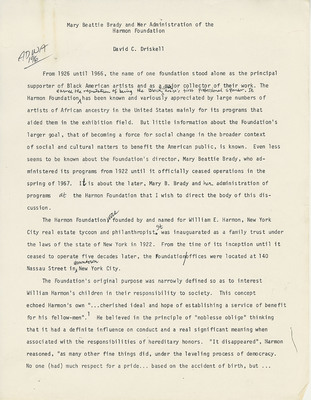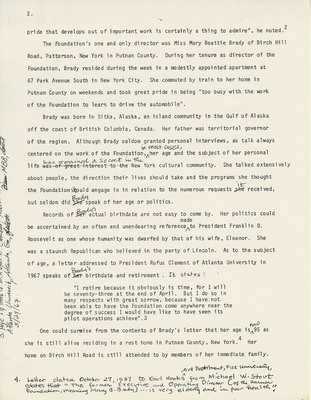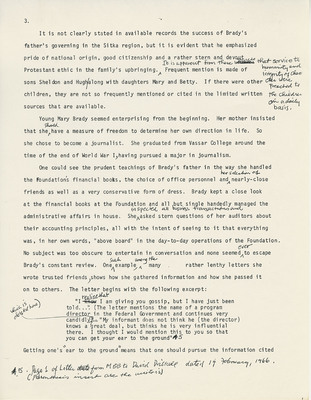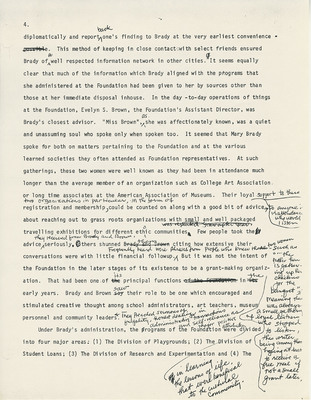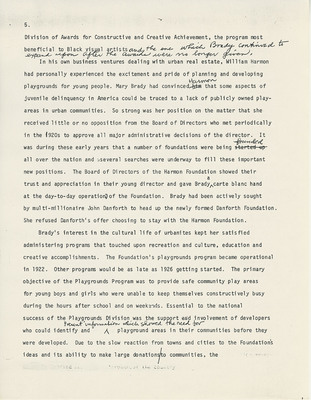Pages
MS01.01.03.B02.F23.068
Mary Beattie Brady and her Administration of the Harmon Foundation David C. Driskell
From 1926 until 1966, the name of one foundation stood alone as the principal supporter of black American artists and as a major collector of their work. The Harmon Foundation earned the reputation of being the black artist's first professional sponsor. It has been known and variously appreciated by large numbers of artists of African ancestry in the United States mainly for its programs that aided them in the exhibition field. But little information about the Foundation's larger goal, that of becoming a force for social change in the broader context of social and cultural matters to benefit the American public, is known. Even less seems to be known about the Foundation's director, Mary Beattie Brady, who administered its programs from 1922 until it officially ceased operations in the spring of 1967. It is about the later, Mary B. Brady and her administration of programs at the Harmon Foundation that I wish to direct the body of this discussion.
The Harmon Foundation was founded by and named for William E. Harmon, New York City real estate tycoon and philanthropist. He was inaugurated as a family trust under the laws of the state of New York in 1922. From the time of its inception until it ceased to operate five decades later, the Foundation offices were located at 140 Nassau Street in downtown New York City.
The Foundation's original purpose was narrowly defined so as to interest William Harmon's children in their responsibility to society. This concept echoed Harmon's own "... cherished ideal and hope of establishing a service of benefit for his fellow-men". He believed in the principle of "noblesse oblige" thinking that it had a definite influence on conduct and a real significant meaning when associated with the responsibilites of hereditary honors . "It disappeared", Harmon reasoned, " as many other fine things did , under the leveling process of democracy . No one (had) much respect for a pride ... based on the accident of birth, but...
MS01.01.03.B02.F23.069
2. pride that develops out of important work is certainly a thing to admire", he noted. The Foundation's one and only director was Miss Mary Beattie Brady of Birch Hill Road, Patterson, New York in Putnam County. During her tenure as director of the Foundation, Brady resided during the week in a modestly appointed apartment at 67 Park Avenue South in New York City. She commuted by train to her home in Putnam County on weekends and took great pride in being "too busy with the work of the Foundation to learn to drive the automobile". Brady was born in Sitka, Alaska, an island community in the Gulf of Alaska off the coast of British Columbia, Canada. Her father was territorial governor of the region. Although Brady seldom granted personal interviews, as talk always centered on the work of the Foundation, [*in most cases*] her age and the subject of her personal life [was of great interest to the] has remained a secret in the New York cultural community. She talked extensively about people, the direction their lives should take and the programs she thought the Foundation should engage in in relation to the numerous requests [she] it received, but seldom did [she] Brady speak of her age or politics. Records of [her] Brady's actual birthdate are not easy to come by. Her politics could be ascertained by an often and unendearing reference made to President Franklin D. Roosevelt as one whose humanity was dwarfed by that of his wife, Eleanor. She was a staunch Republican who believed in the party of Lincoln. As to the subject of age, a letter addressed to President Rufus Clement of Atlanta University in 1967 speaks of [her] Brady's birthdate and retirement. It states :
"I retire because it obviously is time, for I will be seventy-three at the end of April. But I do so in many respects with great sorrow, because I have not been able to have the Foundation come anywhere near the degree of success I would have like to have seen its pilot operations achieve." .3
One could surmise from the contents of Brady's letter that her age is now 95 as she is still alive residing in a rest home in Putnam County, New York. 4 Her home on Birch Hill Road is still attended to by members of her immediate family.
4. Letter dated October 27, 1987 to Earl Hooks, Art Department, Fisk University, from Michael W. Stout states that "The former Executive and Operating Director (of the Harmon Foundation, meaning Mary B. Brady)...is very elderly and in poor health."
[left margin: 3. page 1 of letter to Dr Rufus Clement, President of Atlanta University, Atlanta, Ga. [illegible] [illegible] MBB, dated 3/29/67.]
MS01.01.03.B02.F23.070
It is not clearly stated in available records the success of Brady's father's governing in the Sitka region, but it is evident that he emphasized pride of national origin, good citizenship and a rather stern and devout Protestant ethic in the family's upbringing. It is apparent from these findings that service to humanity and integrity of character were preached to the children on a daily basis. Frequent mention is made of sons Sheldon and Hugh, along with daughters Mary and Betty. If there were other children, they were not so frequently mentioned or cited in the limited written sources that are available. Young Mary Brady seemed enterprising from the beginning. Her mother insisted that she should have a measure of freedom to determine her own direction in life. So she chose to become a journalist. She graduated from Vassar College around the time of the end of World War I, having pursued a major in journalism. One could see the prudent teachings of Brady's father in the way she handled the Foundation's financial books, the choice of office personnel and her selection of nearly-close friends as well as a very conservative form of dress. Brady kept a close look at the financial books at the Foundation and all but single handedly managed the administrative affairs in house. She inspected all business transactions and asked stern questions of her auditors about their accounting principles, all with the interest of seeing to it that everything was, in her own words, "above board" in the day-to-day operations of the Foundation. No subject was too obscure to entertain in conversation and none seemed ever to escape Brady's constant review. One such example, among the many rather lenthy [sic] letters she wrote trusted friends shows how she gathered information and how she passed it on to others. The letter begins with the following excerpt: "I realize that I am giving you gossip, but I have just been told...." (The letter mentions the name of a program director (which is deleted here) in the Federal Government and continues very candidly, "My informant does not think he (the director) knows a great deal, but thinks he is very influential there. I thought I would mention this to you so that you can get your ear to the ground". Getting one's "ear to the ground" means that one should pursue the informaton cited. 5. Page 1 of letter from MBB to David Driskell dated 14 February, 1966 (Parenthesis insert are the writer's)
MS01.01.03.B02.F23.071
diplomatically and report [inserted: back] one's finding to Brady at the very earliest convenience [crossed out: possible]. This method of keeping in close contact with select friends ensured Brady of [inserted: a] well respected information network in other cities. [written: H/C] It seems equally clear that much of the information which Brady aligned with the programs that she administered at the Foundation had been given to her by sources other than those at her immediate disposal in house. In the day -to-day operations of things at the Foundation, Evelyn S. Brown, the foundation's Assistant Director, was Brady's closest advisor. "Miss Brown", [inserted: ^ as] she was affectionately known, was a quiet and unassuming soul who spoke only when spoken to. It seemed that Mary Brady spoke for both on matters pertaining to the Foundation and at the various learned societies they often attended as Foundation representatives. At such gatherings, these two women were well known as they had been in attendance much longer than the average member of an organization such as College Art Association or long time associates at the American Associates of Museums. Their loyal [written: support to these two organizations in particular, in the form of] registration and membership [inserted: comma] could be counted on along with a good bit of advice [written: arrow - to anyone in attendance who would listen] about reaching out to grass roots organizations with small and well packaged [written and crossed out: was rejected year after year] traveling exhibitions for different ethnic communities [inserted: period.] Few people took the advice [written: they received from Brady and Brown] seriously. [crossed out: o][written: O]Others shunned [crossed out: Brady and Brown}{written: them] citing how extensive their conversations were with little financial followup. {inserted: Frequently heard were phrases from people who knew these two women - such as "... the mother hen is gathering up her chickens for the banquet" meaning there was always a small gathering of loyal listners who stopped to listen, this writer being among them hoping at least to receive a free meal if not a small grant later. But it was not the intent of the Foundation in the later stages of its existence to be a grant-making organization. That had been one of [crossed out: the] its principle functions [crossed out: of the foundation] in [crossed out: its] the early years. Brady and Brown saw their role to be one which encouraged and stimulated creative thought among school administrators, art teachers, museum personnel and community leaders. [written: arrow - They preached sermons of frugality, honest dealing in administrative transactions and self-reliance as major positive attributes in learning the lessons of life, that was beneficial to the cultural community.]
Under Brady's administration, the programs of the Foundation were divided into four major areas: (1) The Division of Playgrounds; (2) The Division of Student Loans; (3) The Division of Research and Experimentation and (4) The
MS01.01.03.B02.F23.072
5.
Division of Awards for Constructive and Creative Achievement, the program most beneficial to Black visual artists and the one which Brady continued to expand upon after the awards were no longer given.
In his own business ventures dealing with urban real estate, William Harmon had personally experienced the excitement and pride of planning and developing playgrounds for young people. Mary Brady had convinced Harmon that some aspects of juvenile delinquency in America could be traced to a lack of publicly owned playareas in urban communities. So strong was her position on the matter that she received little or no opposition from the Board of Directors who met periodically in the 1920s to approve all major administrative decisions of the director. It was during these early years that a number of foundations were being founded all over the nation and several searches were underway to fill these important new positions. The Board of Directors of the Harmon Foundation showed their trust and appreciation in their young director and gave Brady a carte blanc hand at the day-to-day operations of the Foundation. Brady had been actively sought by multi-millionaire John Danforth to head up the newly formed Danforth Foundation. She refused Danforth's offer choosing to stay with the Harmon Foundation.
Brady's interest in the cultural life of urbanites kept her satisfied administering programs that touched upon recreation and culture, education and creative accomplishments. The Foundation's playgrounds program became operational in 1922. Other programs would be as late as 1926 getting started. The primary objective of the Playgrounds Program was to provide safe community play areas for young boys and girls who were unable to keep themselves constructively busy during the hours after school and on weekends. Essential to the national success of the Playgrounds Division was the support and involvement of developers who could identify and present information which showed the need for playground areas in their communities before they were developed. Due to the slow reaction from towns and cities to the Foundation's ideas and its ability to make large donations to communities, the
